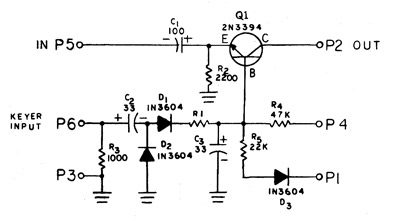X 66
North Suburban HAMMOND ORGAN Service
Percussion Keyers
The purpose of the percussion keyers is to mimic the action of instruments such as a piano or a celesta, for example, where, when you hit a key, the note begins suddenly and loudly and then starts to fade away slowly. If you release a key on a real piano or celesta, a damper contacts the appropriate strings or tuned bars and quickly damps out their vibration, with the result that the tones fade out fairly quickly. If you continue to hold a key down, however, the rate of fade out (decay) is much slower.

Figure 13.
In the X66 Hammond, the action of its percussion keyers parallels this all important behavior of real instruments, resulting in a much better and realistic response than that of the early percussion of traditional Hammonds which rely on a single percussion keyer to handle an entire keyboard, and which cuts off the tone immediately upon key release.
A sawtooth waveform from the tone generator (frequency divider stage) for the required note enters at terminal P5, passes through C1 and appears on the emitter of transistor Q1. With a suitable DC voltage present on the base of Q1, the transistor conducts the signal and it exits the percussion keyer on terminal P2. When you hit a key, 3 volt DC is applied to the keying circuit on terminal P6, and charges capacitors C2 and C3 through diode D1 and resistor R1. At this moment, D2 doesn't do anything. When you release the key, C2 discharges through D2 and R3, which fades the tone out quite fast. Meanwhile, diode D1 keeps C3 from discharging through R3, otherwise when you let go of a key, the tone would stop too quickly. However, if you continue to hold a key down, then the discharge of C3 depends on the voltages present on terminals P4 and P1, and also the equivalent resistance of everything that is in parallel with C3.
For percussion effects that need a long sustain such as chimes, harp and celesta, P1 gets grounded and +0.33 volts DC gets applied to terminal P4. This results in a decay time of between 2 and 3 seconds with the key held down. For a shorter decay of about 1 second for either the piano or the glockenspiel percussion voices, (key held down) both P1 and P4 get grounded. Finally, for a very short decay percussion effect, such as the marimba or xylophone, +0.33 volts goes to P4 and -0.1 volt goes to P1. Thus, realistic decay times for different percussion voices will result from this circuit, and there is one keyer for every pitch that is used in the percussion system of the X66, as opposed to just one percussion keyer for an entire keyboard as there is in a traditional Hammond, which as we know now is completely contrary to the way in which real musical percussion instruments work. From the percussion keyers, the percussively keyed signals go next to the percussion filter driver circuitry.
Previous Page Page 10. Next page